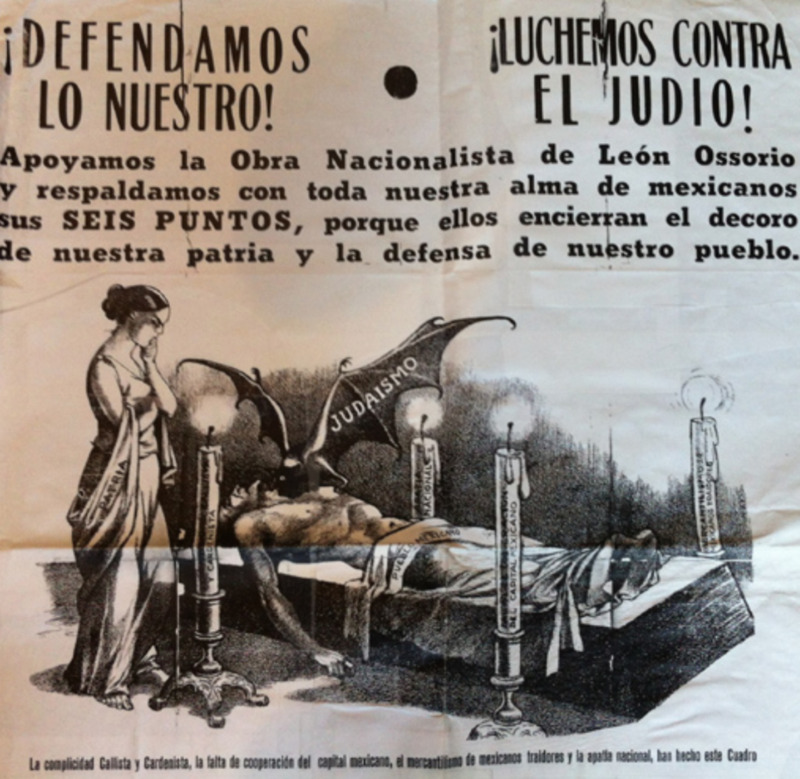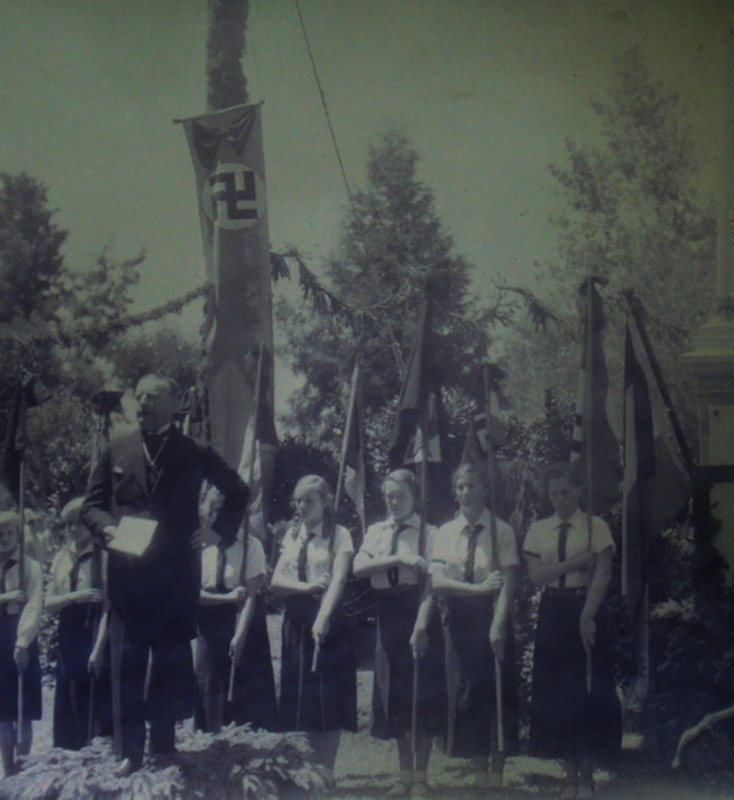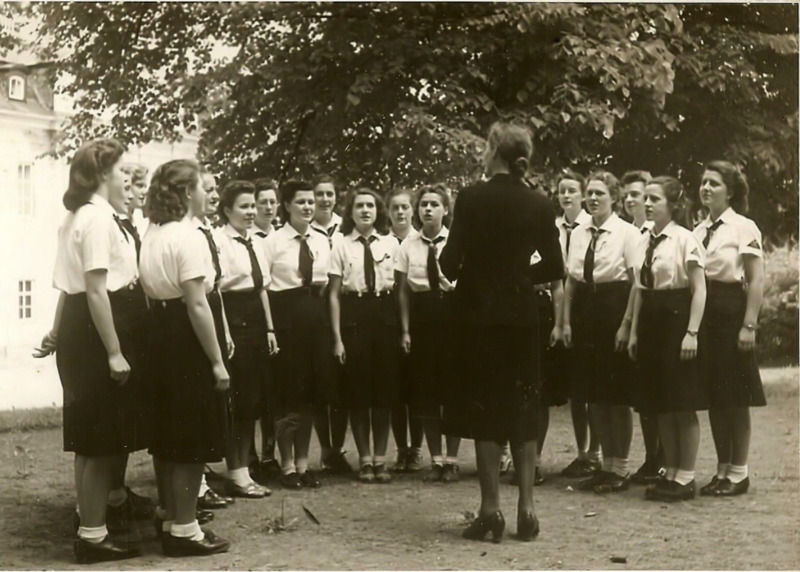Jewish Refugees in Mexico
The Evian Conference and the Question of Jewish Refugees
As the Spanish Civil War droned on and Cárdenas continued to rescue and accept the refugees it produced, the situation for Jews in Europe was becoming increasingly dire, prompting the first attempt at an international response to the global refugee crisis. In March 1938, just a few months before the Mexican government refused entry to Jewish refugees aboard the Orinoco, Mexico’s Minister of Foreign Affairs responded to US President, Franklin D. Roosevelt’s invitation to The Evian Conference (an international meeting in Paris to discuss the resettlement of Jewish refugees fleeing Nazism that would take place in July) on the question of Jewish refugees: “Mexico is most willing to take in the refugees in question, within the limits of our immigration system.” This response gave cause for hope among Jewish organizations within Mexico who had been fighting for the acceptance of Jewish refugees. It is notable here that this was the first time a branch of the Mexican government had referred to Jews fleeing Nazism as refugees. The objective of the Évian Conference was to demonstrate to American public opinion as well as to the rest of the world that the United States was carrying out concrete actions in favor of the victims of Nazism in Austria and Germany. This conference was somewhat symbolic of the dominant international attitude toward Nazism at the time: expressing sympathy for the refugees without making any direct commitments. This is evidenced by the caveat FDR included in his invitation, specifying that “no country would be expected to take in more refugees than its laws permitted.” It is not surprising then, that by the end of the conference, none of the countries involved made any real commitments, and the only tangible result was the creation of an Intergovernmental Committee that would “continue working in favor of the refugees fleeing Nazism.”
While in hindsight it is tempting and even logical to view the Evian Conference as a global attempt to develop concrete solutions to an escalating global crisis, it is important here to contextualize the situation internationally in 1938. The debate regarding who among the international community knew what, and when about the state of affairs for Jewish people in Nazi Germany is provocative and ongoing, but it is evident that when the Evian Conference convened in 1938, there was not yet a Holocaust from which the Jews needed saving. This is a critical qualifier when considering the goals of the conference, and the motivations of everyone involved. As Australian historian of the Holocaust and genocide, Paul Bartrop, succinctly opens his 2017 book and significant historiographical contribution entitled The Evian Conference of 1938 and the Jewish Refugees: “This is a story about a joint global effort which had as its major objective the quest to do nothing.” He goes on to outline what he believes the conference set out to accomplish: “...the intention of discussing, in depth, the nature of the immigration policies of the invited nations, and, in accordance with those, what the options were for accepting refugees from Nazi Germany. Those attending were there to consider what steps could be taken to facilitate refugee migration … but no country was expected in any way to depart from its existing immigration regulations.” Bartrop argues that these expectations, or lack thereof, were clear before the conference convened, and in fact demonstrated in some of the hesitant acceptances of FDR’s invitation. While as Bartrop puts it, all of the Latin American countries “agreed to attend without hesitation” this agreement was predominantly motivated by a unanimous realization “that their interests lay in supporting the United States,” rather than any humanitarian mission.
While Bartrop characterizes British participation as most significant to the impending success of the Evian Conference, I would argue that the participation of Latin America was equally significant, for they represented the largest bloc of nations at Evian, and unlike Britain, had organized Jewish communities dating from the 1880s, that were well established by the 1930s. However, while Bartrop contends that expectations were high among the US and Europe that Latin America would make a substantial contribution to alleviating the crisis, as American historian Henry Fenigold points out, even before the conference began, the responses of several Latin American countries “contained some expression of their reluctance to accept more refugees.” That being said, like their European counterparts, the speeches delivered by the Latin American delegates were relatively consistent. However, the themes prevalent throughout the speeches were decidedly distinct from those drawn on from the countries of Europe: without exception, all of the Latin American delegates were eager to align themselves with President Roosevelt, almost all of them thanking the US President seeking to demonstrate cooperation and goodwill toward the US despite their clear attempts at manipulation. This almost unanimous expression of outright support for US initiatives is significant, as it is indicative of the trend most Latin American countries exhibited in adjusting their foreign policies to align specifically with the US as the situation in Europe escalated.
Another theme common among most Latin American delegates was the emphasis of the primarily agricultural based economies throughout the region. As we have seen previously in Mexico, this was a critical component of immigration policy throughout this period. Many Latin American government’s feared welcoming foreigners as professionals and industrialists, as they anticipated competition with their native workers. Delegates from Argentina, Chile, Colombia, Ecuador, Uruguay, Venezuela, Peru, Paraguay, Haiti, and even Trujillo’s authoritarian regime in the Dominican Republic expressed the concern of incoming Jewish refugees assimilating into their agriculturally based economies, and expressed their willingness to accept more refugees only with the contingency that they enter the agricultural sect of their economies. For example, Argentina’s Dr. Tomas Le Breton adamantly insisted that Argentina was “above all, an agricultural country,” and that immigration therefore had to be “directed towards agricultural work and certain specialized forms of employment,” and Ecuador’s Alejandro Gastelu Concha clearly stated that “Ecuador is an essentially agricultural country” it was impractical to admit “too great an influx of intellectual workers.” Once again, this underlines the overwhelming desire for each state to act in their own self interest, as well as the widespread belief that Jewish refugees would be incapable of assimilating into Latin American economies.
Mexico at the Evian Conference
When it came time for the Intergovernmental Committee to convene in August, 1938, Mexico sent Gustavo Luders de Negri, the consul general in London, as their delegate. At the conference, de Negri nonchalantly made his personal anti-Semitic views known:
"It is well known that the elements who seek refuge make up nonassimilable groups and that the experiences of other countries has shown that, in the long run, when the number of Jews is considerable, they become an exclusive caste, dominating and powerful, having no ties to internal problems. If we must take them in, it should be as few as possible, selecting them carefully, and only when they will not constitute an economic or ethnic burden to the country."
De Negri’s views seem to be strongly influenced by the project of Mestizaje and the Mexican government’s ideals on which populations should be allowed to assimilate into Mexico. He emphasizes these beliefs quite explicitly by referring to Jews as an “ethnic burden”, as they would not contribute to the Mexican populace. However, de Negri’s comments add a new element to the Mexican government’s anti-Semitic ideals by referencing the fear of Jews prevalent at the time. He warns that if a country should allow too many Jews in, they will become “dominating and powerful”. Using these adjectives shifts the focus away from the fact that the Jews in question were refugees facing extermination. While Jewish refugees had no control over their circumstances or where they would end up, de Negri paints a picture of manipulative, dangerous people that the public should fear.
Beyond his personal opinions, the Mexican delegate’s general impression of the first meeting of the Intergovernmental Committee was that there was a general lack of commitment and an obvious manipulation of all matters by the United States, France, and England. In this sense, there was a clear intention to use Latin America to “free Europe of great masses of surplus population—mainly Jews—in order to alleviate the economic situation of certain countries.” The fact that the other countries in attendance might not have been committed would have made it easier for Mexico to attend the meetings without making any real commitments toward accepting Jewish refugees. Furthermore, the obvious and condescending manipulation of Latin American countries by major powers seemed to frustrate de Negri.
This is reflected in the way that de Negri’s suggestions to the Mexican government changed over time. At that first meeting in August 1938, de Negri proposed a strategy that would maintain Mexico’s goodwill with the United States, without “burdening” Mexico, proposing “in order to give proof of Mexico’s goodwill in helping find a solution to this problem, Mexico should take in up to one thousand refugees a year.” However, upon viewing the lack of commitments by other countries involved, including the major world powers, de Negri’s suggestions became more restrictive. In January 1939, for example, he recommended “that our answer be worded in such a way that it leaves the door open for accepting only those elements that it would be in the interest of the country to accept, letting in only a limited number of people and only when the economic conditions of the country could absorb them without any detriment to ourselves.” It seems that de Negri’s words reflected the general views of the countries at the conference, for even as the situation for Jews was becoming more dire by the last meeting that took place in October 1939, France and the UK claimed it was impossible for them to continue offering asylum, and in Latin America, all countries except for the Dominican Republic outright refused to receive refugees. In the end, various elements contributed to the failure of the Intergovernmental Committee including a lack of government financing to support refugee resettlement, anti-Semitic attitudes of participating governments (including Mexico), and the failure of negotiations with Germany to allow Jews to take part of their capital out of the Reich. Nonetheless, the failure of this committee marked the impossibility of reaching any international agreement in helping Jewish refugees.
Anti-Semitism in the Mexican Public
Meanwhile, it was clear the anti-Semitic rhetoric prevalent among international representatives and governmental figures within Mexico was having an impact on the Mexican public. This pamphlet, published around 1938 reveals an explicit attempt to rally Mexicans against the Jewish cause. Judaism is represented by an extremely large bat, which in the Zapotec civilization bat god was related to the sacred world of the dead and the spirit ancestors that roamed the underworld. The jarring image of the bat feeding off of the figure representing the Mexican public is a representation of de Negri’s suggesting that Jews in Mexico would become “dominating and powerful,” as it illustrates Judaism feeding off of a weakened Mexican public for its own benefit. It is significant here that the bat is targeting the heart of the man in the image. The man appears young, strong, and able bodied, and the bat is taking the heart that makes all of those qualities possible and keeps the Mexican public alive. Furthermore, the decision to have the bat go after the heart of the Mexican people can be a reference to the destruction Jews would bring to the project of Mestizaje, as the bat is going after the very composition of the Mexican people.
The imagery here appeals to the deep Catholic values prevalent in Mexican society, which would be an effective method of rallying support. In the Catholic religion, candles generally represent Jesus coming as the light in darkness. In this case, Mexico’s institutions are represented by each of the candles, as Judaism imposes darkness from the underworld. The placement of the figures is also significant here, as the Mexican public is the only thing in between Judaism and the woman representing the motherland of Mexico itself. The woman appears angry, likely frustrated with the Mexican public for failing to protect themselves and her against Judaism. The pamphlet is suggesting then, that a failure to act against the Jews is a failure to protect the motherland. The fact that the figure representing Mexico is a woman indicates that she must be taken care of and protected, as she is unable to protect herself. The pamphlet then could be viewed as a call upon the Mexican public to protect their motherland. This idea is reinforced explicitly with the large text at the top reading “Defendamos lo Nuestro!” (Protect ourselves) and “Luchamos Contra el Judio!” (Let’s fight against the Jews!). Using first person perspective here is a call for unity against what this pamphlet describes as a national threat. The first person perspective continues when they point to Leon Osorio specifically, reading “Apoyamos la Obra Nacionalista de León Ossorio y respaldamos con toda nuestra alma de mexicanos” (We support the Nationalist Work of Leon Ossorio and we support with all our Mexican soul). The choice to use the phrase Mexican soul here reinforces the imagery of the Jews trying to take the heart of the Mexican people. Furthermore, the reference to Ossorio specifically reveals that the ideas of Mexican political figures were having an influence on the views of the Mexican public.
This public influence is further illustrated through this image, a photograph taken between 1937 and 1938, depicting a pro-Nazi demonstration in Mexico, composed mainly of young girls. The photograph on the right reveals that the outfits the girls adorn bare a striking resemblance to the uniforms of Bund Deutscher Mädel (BDM, or League of German Girls), the sister organization to Hitlerjugend (HJ, or Hitler Youth). It is clear then that this demonstration in Mexico sought to mimic the style and values of Hitler youth, though it is interesting that I have not found a similar photograph of young boys. All of the girls in the photographs appear holding flags, and three of them appear to be the Mexican flag. This draws an explicit connection for this group between Mexican national identity and Nazi values. Additionally, the fact that the demonstration is taking place outside meant that the group was comfortable displaying blatant Nazism in a public setting without fear of protest.
While I cannot be sure why this group chose to focus on young girls to recruit for a Nazi organization, we can refer to the main objective of the League of German Girls, which the group in the photograph was clearly trying to emulate. The Hilter youth organizations were implemented to promote the longevity of Nazi values. This meant recruiting boys and girls and instilling a commitment to Nazism and articulating their life purpose. For the League of German Girls, this meant being “dutiful housewives, and whose role within society was to become a mother.” Thus, if this group in Mexico was trying to emulate these ideals, there was likely an emphasis on molding the girls in Figure 3a into good housewives and mothers. If anti-Semitic ideals were prevalent in the Mestizaje national project, it makes sense that the sentiments from that ideology would manifest in practical ways through young girls, as they would be the ones deciding who to reproduce with and add to the national project.


